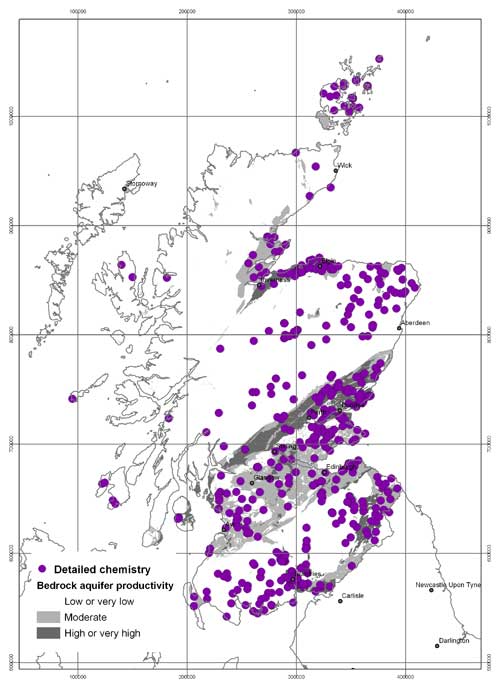Baseline sampling and analysis methodology
Sample site selection
The criteria for site selection during dedicated Baseline sampling surveys are:
- to collect a suitable number of samples from each of the studied aquifer types, according to the distribution and areal extent of the aquifers;
- to collect samples distributed as evenly as possible over each of the aquifer types studied; and
- to collect samples that are as far as possible representative of groundwater in the studied aquifers.
The primary criteria for including additional data from earlier studies was the demonstationdemonstration of suitable robust sampling and analysis procedure. The distribution of baseline samples collated to 2010 is shown in Figure 1.
The sites for all samples considered in the Baseline project are chosen to be representative of groundwater in the local area. Sources that are very poorly constructed — e.g. open and/or uncased boreholes in leaking chambers – and which are close to obvious and significant sources of contamination — e.g. unsecured slurry stores – are avoided.
Each of the sample sites is assessed at the time of sampling, in particular the source construction and the surrounding land use, to identify any potential sources of contamination that could affect the chemistry of sampled groundwater and the risk of contamination.
Sample sources
Across Scotland as a whole, most of the Baseline groundwater samples are collected from boreholes. However, in some regions, particularly in upland areas, springs form a significant proportion of the sources sampled. In all areas, shallow, large diameter wells are typically the least common source type. In the Midland Valley, a small proportion of samples were collected from mine adits, mine shafts, or boreholes intercepting mine workings.
In most cases, the sampled boreholes are pumped regularly in the weeks leading up to sampling. Where boreholes are not pumping on arrival, they are pumped for at least 10 minutes to allow purging before sample collection. Hence, groundwater samples are believed to be as representative of in-situ groundwater as possible. Pumped groundwater samples represent the compositions of water entering the borehole over its open-hole section. As such, the sample may represent a mixture of waters with different chemistry, especially where the borehole screen extends over more than one fracture inflow.
Springs and wells typically tap shallow groundwater and have relatively small catchments, and so are less likely than boreholes to represent a mixture of groundwaters from different depths. Because springs are constantly flowing, they are naturally purged, and the sampled groundwater is therefore likely to be representative of groundwater in the surrounding aquifer. The main reason Baseline samples are not often collected from shallow wells is that they often form poor sampling points, because they are difficult to purge. Wells are only sampled where they are in daily use and the sample obtained is likely to be representative of groundwater in-situ in the aquifer.
Sources that are very poorly constructed — e.g. open and/or uncased boreholes in leaking chambers – and which are close to obvious and significant sources of contamination — e.g. unsecured slurry stores – are avoided.
Sampling and analysis procedure
At each sample site, field measurements are made of:
- pH
- dissolved oxygen (DO)
- redox potential (Eh)
- water temperature
- specific electrical conductance (SEC)
- alkalinity
Where possible, pH, DO and Eh are measured in an in-line flow cell (Figure 2) to minimise atmospheric contamination and parameters were monitored (typically for at least 10 to 15 minutes) until stable readings are obtained. Where not possible, measurements of water as close as possible to the pump outlet are made in a bucket within one to two minutes of abstraction.
Water samples are collected for subsequent laboratory analysis.
- Samples for major- and trace-element analysis are filtered through 0.45 um filters and collected in polyethylene bottles rinsed with sample water before collection. Four filtered aliquots are collected at each site: two are acidified to 1% v/v with Aristar HNO3, one for analysis of major cations, total sulphur and Si by ICP-OES (inductively coupled plasma-optical emission spectroscopy), and the other for a large range of trace elements by ICP-MS (inductively coupled plasma mass spectrometry). A third aliquot is acidified to 1% v/v with Aristar HCl for analysis of As by AFS (atomic fluorescence spectrometry) with hydride generation, to be used if necessary as a check on ICP-MS As analyses. A fourth aliquot is left unacidified for analysis of anions by ion chromatography (Cl, NO3-N, Br, F) and automated colorimetry (NO2-N, NH4-N).
- Samples for dissolved organic carbon (DOC) analysis are also collected in chromic-acid-washed glass bottles, after filtration using silver-impregnated 0.45 μm filters. DOC was measured by carbon analyser.
- Stable-iostopic analysis - at most of the sample sites, additional water samples are collected in glass bottles for stable-isotopic analyses (δ2H, δ18O and δ13C).
- CFC and SF6 analysis – where it is possible to collect an air-free sample direct from the source, samples are also collected CFC and SF6 analysis in glass bottles, submerged under flowing groundwater to prevent atmospheric contamination (Figure 3).
Most analyses are carried out at the BGS laboratories, except for some ICP-MS analysis which were carried out by ACME laboratories, Vancouver, Canada. Charge imbalances are calculated for each sample and reported on, and are typically less than 3%, giving confidence that the analytical results for the major species of all samples are reliable. The BGS laboratories run a series of QA checks, including analysis of certified standards, to ensure that all analyses are within their prescribed limits.
Analyses of total sulphur are expressed as SO4 and alkalinity as HCO3. Analyses of δ2H, δ18O are expressed as per mil deviations relative to VSMOW (Vienna Standard Mean Ocean Water) and δ13C relative to VPDB (Vienna Pee Dee Belemnite).












